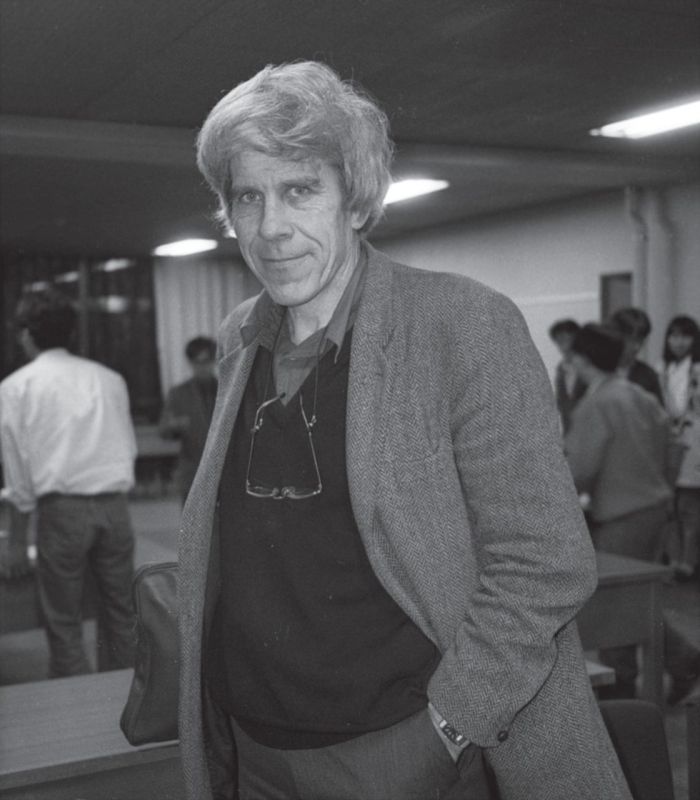
William Donald Hamilton was one of the most influential evolutionary biologists who died on this day (March 7) in 2000.
He revolutionized the field with his 1964 papers The Genetical Evolution of Social Behaviour (links posted under the Publications section). But that was the beginning. He went on publishing very influential papers on broad range of subjects. W.D. Hamilton was one of the original and creative thinkers.
Robert Trivers:
While the rest of us speak and think in single notes, he thought in chords
But too modest.
Richard Dawkins:
Bill published his theory of the sex ratio of honeybees, not in a Note to Nature devoted to the topic, as a normally ambitious scientist would have done, but buried in a review of somebody else’s book.
Hamilton was garlanded eventually with honours, but in a way this only underlined how slow the world was to recognize him. He won many prizes, including the Crafoord Prize
and the Kyoto Prize. Yet his disturbingly candid autobiography reveals a young man tormented by self-doubt and loneliness. Not only did he doubt himself; he was led to doubt even whether the questions that obsessively drove him were of any interest to anybody else at all. Not surprisingly, this even occasionally led him to doubt his sanity. The experience gave him a lifelong sympathy for underdogs, which may have motivated his recent championing of an unfashionable, not to say reviled, theory of the origin of human AIDS.
In his piece ‘No Stone Unturned: A Bug-Hunter’s Life and Death’ he wrote about his compulsive bug-hunting activities as a kid:
What remains from all that fanatical activity? An odd and socially underdeveloped personality is probably the most conspicuous consequence as far as my friends and family are concerned. On the positive side, there had undoubtedly also been the gradual introduction of a rather vague and illogical brain into the endless fascination of science. But above both good and bad legacies, from my own point of view it has helped me to carry on from childhood to adult life a deep and never-ending sense of freshness and excitement, a constant astonishment at the workings of the natural world.
And in his essay ‘My intended burial and why’ he wrote on death:
Soaked, I hurry to my dinner the open iron-roofed canteen Reserva Ducke. It is a chicken here too – fried, of course – but I am thinking more of the mysteries of the forest undetakers I have been watching and of their chicken and what they are doing with it. I think of how they sometimes bury their carcass entire, as a team, several pairs together, while other times, even though quite as many are present, they work to remove its flesh on the surface in the way I have above described. When they work together are they all siblings or cousins? Could they know about this?…Shivering a little I think of how, by the time I am old, all these secrets of their work will be known, of how easily, then, superattract beetles if we care to form large areas of forest by means of foetid chemicals…I think how, by that time, I can confidently arrange what i have thought of. I will leave a sum in my last will for my body to be carried to Brazil and to the forests. It will be laid out in a manner secure against the possums and the vultures just as we make our chicken secure; and this great Coprophanaeus beetle will bury me. They will enter, will bury, will live on my flesh; and in the shape of their children and mine, I will escape death. No worm for me nor sordid fly, I will buzz in the dusk like a huge bumble bee. I will be many, buzz even as a swarm of motorbikes, be borne, body by flying body out into the Brazilian wilderness beneath the stars, lofted under those beautiful and un-fused elytra which we will hold over our backs. So finally I too will shine like a violet ground beetle under a stone.
Books: Click on the cover pictures to go to Amazon page.

Publications:
- ‘The Evolution of Altruistic Behaviour’ – W. D. Hamilton (The American Naturalist: 1963)
- ‘The Genetical Evolution of Social Behaviour-1’ – W. D. Hamilton (Journal of Theoretical Biology: 1964)
- ‘The Genetical Evolution of Social Behaviour-2’ – W. D. Hamilton (Journal of Theoretical Biology: 1964)
- ‘The Moulding of Senescence by Natural Selection’ – W. D. Hamilton (Journal of Theoretical Biology: 1966)
- ‘Geometry for the Selfish Herd’ – W. D. Hamilton (Journal of Theoretical Biology: 1971)
- ‘The Evolution of Cooperation’ – W. D. Hamilton (Science, New Series: 1981)

Articles:
- ‘Then and Now’ – W. D. Hamilton (The Times Literary Supplement)

Related Videos:
- Bill Hamilton – John Maynard Smith (Web of Stories)
- The First Idea of Population Regulation by Group Selection – John Maynard Smith (Web of Stories)
- Hamilton and Haldane’s Ideas of ‘Inclusive fitness’ – John Maynard Smith (Web of Stories)
- Hamilton: Political and Ideological Commitment – John Maynard Smith (Web of Stories)
- W. D. Hamilton: Inclusive Fitness – John Maynard Smith (Web of Stories)
 Obituaries:
Obituaries:
- ‘W. D. Hamilton, an Obituary’ – Richard Dawkins (Edge)
- ‘W. D. Hamilton’ – Alan Grafen (The Guardian)
- ‘In Memory of Bill Hamilton’ – Robert Trivers (Nature)
- ‘William Donald Hamilton’ – Alan Grafen (Royal Society)
- The nearest we got to Darwin-eulogy for W. D. Hamilton – Richard Dawkins – Richard Dawkins
- ‘Memorial to Bill Hamilton’ – Robert May
Biography: click on the cover picture to go to Amazon page.





One thought on “W. D. Hamilton (1 August 1936 – 7 March 2000)”